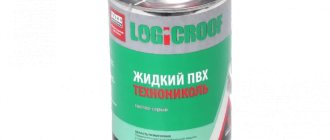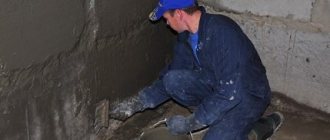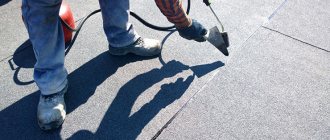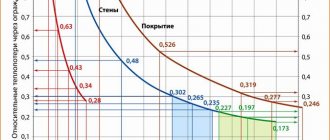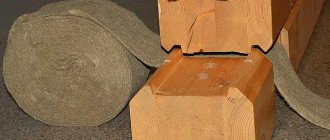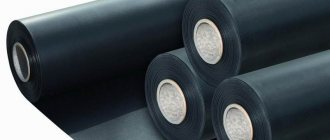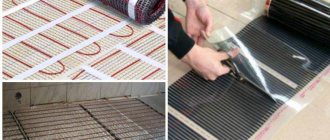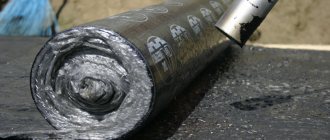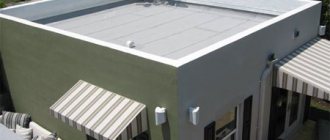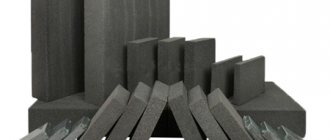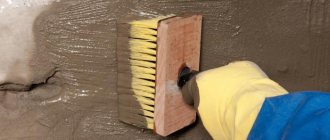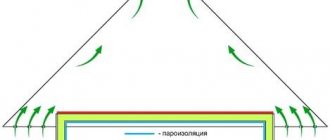At the beginning of the article, we offer you links to the type of roll waterproofing you are interested in:
- Bituminous built-up waterproofing – has high puncture resistance;
- Membrane waterproofing:
- PVC membranes are a durable, vapor-permeable rolled material;
- TPO membranes are a very durable, high-strength rolled material;
- EPDM membranes – durable and elastic waterproofing;
Each type of roll waterproofing is used for both roofing and underground structures. Drinking tanks and swimming pools are usually waterproofed with a PVC membrane.
What is roll waterproofing?
Rolled waterproofing is waterproofing membranes supplied to a construction site in finished form rolled into rolls. The most common are: built-up bitumen membranes; bitumen membranes for mechanical fastening; PVC, TPO and EPDM membranes are fixed mechanically or using ballast.
The sheets of bitumen roll materials are connected to each other using the fire method, PVC and TPO membranes - with hot air, EPDM - by the adhesive method.
Application of roll waterproofing
To increase the service life and protect the foundation of buildings from destruction caused by a damp environment, high-quality roll waterproofing is performed. The universal material has many advantages. Easy to install, no special skills or experience required. Produced in different modifications. It is used to protect walls, foundations, roofs, hydraulic structures and water supply networks.
In the article we will look at the different types and classes of roll waterproofing, characteristics of materials, symbols, installation rules, pros and cons of application.
Waterproofing prevents premature destruction of materials used in the construction of various structures and buildings. It ensures the integrity of protective coatings, prevents moisture from entering building elements and significantly extends the life of buildings.
Pasted waterproofing
Rolled waterproofing can be made on the basis of various materials. The simplest types of roofing felt have a paper base; more modern coatings are made using various polymers (including polyvinyl chloride (PVC) or fiberglass).
Installation on various surfaces can be carried out using special mastics or adhesive mixtures:
- Mastic based on tar (most often used for ordinary roofing felt, recently used rarely).
- Mastic based on bitumen, including modified.
- Adhesive mixtures based on epoxy resins.
Labeling such roll materials does not require the use of special equipment.
The technology for performing the work is as follows:
- A layer of mastic or glue is applied to the prepared base.
- A roll of material is rolled out over the surface.
- After leveling the coating, it is rolled with a special massive roller or roller, which ensures a reliable fit of the material over the entire surface. In addition, this treatment allows you to remove residual air from under the coating.
Roll waterproofing of a foundation or roof is usually performed in several layers, this increases resistance to mechanical damage. When installing in multiple layers, insulation strips must be laid so that the joints in adjacent layers are offset.
Application area
Roll waterproofing has a wide range of applications in the construction industry.
Where and for what is rolled waterproofing material used:
- during the construction of buildings for moisture protection of the foundation;
- when laying the floor;
- when creating a roof to ensure the safety of roofing materials;
- for moisture insulation of basements and cellars;
- to protect walls indoors;
- during the construction of hydraulic engineering and water supply networks;
- when arranging swimming pools and fountains.
The principle of waterproofing a wooden floor
Firstly, the floor for the bathroom is made lower than the level of all other rooms. This is done so that in case of any leakage, the water remains in the place where it occurred, that is, in our case, in the bathroom. The transition between floor levels will prevent water from leaking into other rooms. As a rule, the difference in floor levels is up to 10 cm.
Secondly, the floor is laid on wooden logs, which must be treated with antiseptic impregnation and waterproofing materials.
Thirdly, a subfloor is laid on the treated joists. Rolled waterproofing is applied over the subfloor. Next comes the floor tiles.
Classification of roll insulation
Manufacturers produce various brands of roll waterproofing, distinguished by base material and method of fastening. The material has different coverage widths. When choosing, the scope of application, features and surface area where waterproofing work will be carried out are taken into account.
Based on base material
Rolled waterproofing differs into several types based on the base material. Each of them has characteristic technical features.
Classification by material:
- Polymer membrane waterproofing. The material is made of reinforced polyethylene. There are also types on mastic. Widely used when laying roofing coverings. Provides reliable hydro- and vapor barrier of surfaces.
- Bitumen waterproofing. It is divided into several types according to the base material - cardboard, fiberglass, polyester fabric. Used when laying floors, foundations, roofs, walls.
By installation method
According to the installation method, they are classified into three main types: self-adhesive, weld-on waterproofing and mechanically fastened material.
Bituminous built-up roll waterproofing is widely used and can be easily and quickly fixed to various surfaces. When laying, a gas burner is used to heat the bottom of the material, which ensures a tight and reliable fit to the surface.
Self-adhesive roll material has an adhesive bottom base. During installation, heating is also performed, followed by fixation to the surface to be waterproofed, previously cleaned and properly prepared. Installation requires certain skills and experience.
Fixing the material mechanically involves the use of a construction gun. If necessary, the formed joints are sealed with profile slats.
Waterproofing options
Depending on the slope of the treated base, waterproofing is performed with horizontal or vertical application of a protective layer.
Horizontal
This gluing method is used for processing flat roofing structures, foundations, and floors. The installation of adhesive waterproofing is carried out using the following technology:
- The treated surface is free from dust, dirt, and construction debris.
- Check the integrity of the base, remove chips, cracks and other defects if necessary, and treat with a primer.
- Roll out the rolled material so that it is level.
- Bitumen mastic is heated in a metal container with a gas or gasoline burner.
- A 2 mm thick layer of mastic is applied to a dry surface and distributed evenly with a roller or brush.
- The rolled material is glued onto heated bitumen, overlapping the sheets by 200 mm and expelling the air.
- The first protective layer is again treated with bitumen mastic and the procedure is repeated.
You can stick 2-3 layers of rolled material and even more - there are no specific recommendations on this issue.
Vertical
Waterproofing is used to protect plinths, walls, partitions and other vertical surfaces. Differences in the relief of the base are allowed, but it is impossible for voids to remain under the protective layer, for example, seams between bricks or slabs. The technology of adhesive waterproofing occurs as follows:
- prepare the base - clean, level, dry;
- cut the rolled material into measured pieces equal to the height of the base;
- coat the vertical surface with hot mastic (layer – 2 mm);
- “roll out” the first canvas in the direction from bottom to top;
- press the material tightly against the wall, glue the next sheet overlapping by 2-3 cm;
- The first layer of insulation is again treated with bitumen and the pasting is repeated.
To create a more durable coating, mastic is applied to the last layer of waterproofing material and sprinkled with fine-grained quartz sand.
Important! Protection of walls and ceilings can be done in 2-3 layers and no more - too thick a coating will not stay on a vertical plane.
Types and classes of rolled waterproofing materials
Based on their performance properties, roll waterproofing materials are divided into four categories: premium, business, standard and economy.
Premium
The most expensive material in the line of roll waterproofing, characterized by high quality, best durability and long service life (at least 25 years). Withstands a wide temperature range. Various applications. It can have a base made of polyester fabric, fiberglass, or fiberglass.
Business
Business class material is sold at a more affordable price. Its performance characteristics are slightly inferior to the premium class. Service life – 15-20 years. Base material – fiberglass, polyester fabric, fiberglass. Provides reliable protection against moisture. Widely used in construction and building furnishings. Suitable for waterproofing foundations and roofs.
Standard
The optimal combination of quality and price. Maximum service life is 10-15 years. The basis of the material is fiberglass, fiberglass. It is used for waterproofing walls, floors, roofs, and foundations.
Economy
The cheapest material from the line of rolled waterproofing. Operational characteristics are significantly inferior to the first three classes. Maximum service life is 5 years. This material is often used to create temporary coverings and in the construction of non-residential buildings.
Membrane roll materials
The technology of roll waterproofing using membrane films is relatively new; it is characterized by speed of execution, good quality of protection from ground and sedimentary waters, and resistance to foundation shrinkage. Materials for horizontal and vertical waterproofing are different.
To waterproof the vertical external walls of the foundation, which are subject to loads from the soil, a profiled membrane is used, which has the ability to evenly distribute pressure over the surface of the foundation. Protrusions in the form of spikes are located on the outside of the material and protect the inner membrane from damage. In addition, moisture condenses on the studded surface and, thanks to the gaps and loose contact of the soil, flows into the drainage device. For horizontal waterproofing, a smooth film is used; its purpose is to prevent the capillary rise of groundwater through the pores of concrete.
The technology for installing membrane films is somewhat different: a studded membrane for vertical waterproofing is attached using PVC-coated metal elements, securing them to the foundation wall and welding the film to them using a construction hair dryer. A smooth film for horizontal waterproofing is laid in overlapping strips and welded with hot air.
Membrane film installation technology
Symbols (labeling)
The packaging of roll waterproofing must have a letter marking. Based on these values, the characterizing characteristics of the material are determined.
Explanation of markings:
- Waterproofing base: T - frame fiberglass fabric, S - soft fiberglass fabric, E - polyester fiber, X - fiberglass, O - cardboard.
- Top protective layer: M/K – fine-grained/coarse-grained crumb, P – film.
- Bottom protective layer: M – sand (fine-grained crumbs), C – self-adhesive base, B – air layer.
Advantages and disadvantages
Roll waterproofing is widely used in the construction industry and in repair work. The material has many advantages, it is easy to install and has a long service life.
Advantages of waterproofing:
- protects surfaces from moisture and temperature changes;
- normalizes indoor humidity levels;
- reduces the likelihood of the formation of fungi and mold;
- increases the service life of the foundation, preventing its premature destruction under the influence of a humid environment;
- the material is environmentally friendly for humans;
- waste-free installation;
- maintains protective properties throughout the entire service life;
- the material is resistant to stretching and deformation;
- strong fixation to surfaces;
- easy and quick installation.
Disadvantages of roll waterproofing:
- preliminary surface preparation is required;
- after opening the package, the material emits an unpleasant specific odor;
- In order for waterproofing to create reliable protection and last a considerable period of time, installation must be carried out according to technological rules.
Experts recommend installing roll waterproofing in dry, warm weather, not lower than 5 degrees Celsius. If work is carried out indoors, it must be well ventilated.
